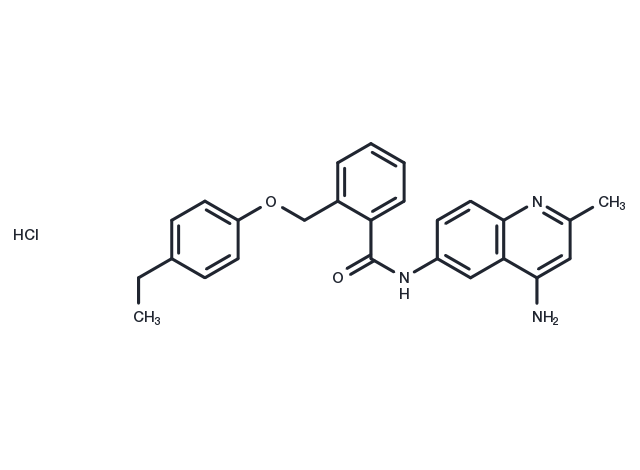Powder: -20°C for 3 years | In solvent: -80°C for 1 year


JTC-801 is a selective opioid receptor-like1 (ORL1) receptor antagonist with IC50 of 94 nM, weakly inhibits receptors δ, κ, and μ.

| Pack Size | Availability | Price/USD | Quantity |
|---|---|---|---|
| 5 mg | In stock | $ 41.00 | |
| 10 mg | In stock | $ 66.00 | |
| 25 mg | In stock | $ 144.00 | |
| 1 mL * 10 mM (in DMSO) | In stock | $ 65.00 |



| Description | JTC-801 is a selective opioid receptor-like1 (ORL1) receptor antagonist with IC50 of 94 nM, weakly inhibits receptors δ, κ, and μ. |
| Targets&IC50 | ORL1:94 nM |
| In vitro | JTC-801 displays about 12.5-, 129-, and 1055-fold selectivity for ORL1 receptor (Ki = 8.2 nM) over μ-, κ-, and δ-opioid receptors, respectively. JTC-801 does not inhibit forskolin-stimulated cyclic AMP accumulation in human ORL1 receptor-expressing HeLa cells, but it prevents nociceptin-induced inhibition of cyclic AMP accumulation, indicating that JTC-801 possesses full antagonistic activity. [2] In rat cerebrocortical membrane, JTC-801 inhibits ORL1 receptor with IC50 of 472 nM and μ-receptor with IC50 of 1831 nM. JTC-801 completely antagonizes the suppression of nociceptin on forskolin-induced accumulation of cyclic AMP with IC50 of 2.58 μM in HeLa cells expressing ORL1 receptor. [1] |
| In vivo | Oral administration of JTC-801 (0.3-3 mg/kg) antagonizes nociceptin-induced allodynia in mice, and shows analgesic effect in a hot plate test using mice and in a formalin test using rats. [2] In mouse hot-plate test, JTC-801 prolongs escape response latency (ERL) or exposed heat stimulus with minimum effective doses (MED) of 0.01 mg/kg by i.v. or 1 mg/kg by p.o. In the rat formalin test, JTC-801 reduces both the first and second phases of the nociceptive response with MED of 0.01 mg/kg71 by i.v. or 1 mg/kg by p.o. [1] JTC-801 dose-dependently normalizes paw withdrawal latency (PWL). Although JTC-801 does not inhibit a chronic constriction injury (CCI)-induced decrease in bone mineral content (BMC) and bone mineral density (BMD), it inhibits an increase in the number of osteoclasts. [3] Tactile allodynia induced by L5/L6 spinal nerve ligation is reversed by both systemic (3-30 mg/kg) and spinal (22.5 and 45 pg) JTC-801 in a dose-dependent manner. Furthermore, systemic JTC-801 reduces Fos-like immunoreactivity in the dorsal horn of the spinal cord (laminae I/II). [4] JTC-801 produces dose-dependent mechanical and cold anti-allodynic effects with ED50 of 0.83 mg/kg and 1.02 mg/kg, respectively. [6] |
| Kinase Assay | A suspension of membranes from human μ-opioid receptor-expressing CHO-K1 cells in 50 mM Tris-HCl buffer (pH 7.4) containing 5 mM MgCl2 and 10% sucrose is incubated at room temperature for 2.5 h with 0.33 nM 3H-labeled diprenorphine and various concentrations of JTC-801. The membranes are collected by filtration using Whatman 934-AH, and radioactivity is counted with a TopCount A9912V scintillation counter. Nonspecific binding (6.4%) is determined with 10 μM naloxone. Specific binding is calculated by subtracting nonspecific binding from the total binding. Data are the mean±SE (n=3). |
| Synonyms | JTC 801, JTC801 |
| Molecular Weight | 447.96 |
| Formula | C26H25N3O2·HCl |
| CAS No. | 244218-51-7 |
Powder: -20°C for 3 years | In solvent: -80°C for 1 year
DMSO: 44.8 mg/mL (100 mM)
Ethanol: 9 mg/mL (20 mM)
You can also refer to dose conversion for different animals. More
bottom
Please see Inhibitor Handling Instructions for more frequently ask questions. Topics include: how to prepare stock solutions, how to store products, and cautions on cell-based assays & animal experiments, etc.
JTC-801 244218-51-7 Endocrinology/Hormones GPCR/G Protein Neuroscience Opioid Receptor Inhibitor inhibit JTC 801 JTC801 inhibitor
